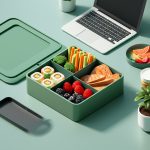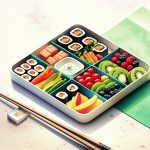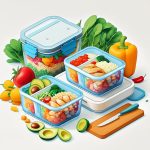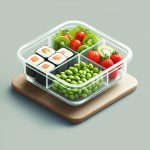Grocery shopping got you stressed? Wish eating healthy was easier on your wallet and your time? This guide shows you how to create a simple, healthy grocery list that works. We’ll cover everything from planning your meals to smart shopping tricks, plus how to avoid wasting food. It’s all about making healthy eating easier and more affordable!
Smart Shopping List for Healthy Eating: Maximizing Nutrition and Minimizing Costs
Let’s make grocery shopping fun and easy again, moving past diet fads and confusing labels. This guide helps you create a shopping list that fuels your body, saves you money, and simplifies your life. Ready to make healthy eating a breeze? Let’s dive in and explore affordable ways to maintain a balanced diet.
1. Strategic Meal Planning: The Foundation of Dietary Wellness
Before you even grab your reusable bags, let’s map out your meals for the week. A simple meal plan provides direction, prevents unhealthy impulse decisions, and minimizes food waste. Tailor it to your tastes and consider your schedule. A well-structured meal plan fosters mindful eating habits, ensuring balanced nutrition.
- Monday: Quick and easy: Sheet pan chicken and veggies (broccoli, peppers, onions). Toss with olive oil, herbs, and spices for extra flavor. Serve with a side of brown rice or quinoa.
- Tuesday: Hearty and healthy: Lentil soup (using canned lentils saves time!) with a slice of whole-wheat toast. Add a dollop of plain Greek yogurt for extra protein and creaminess.
- Wednesday: Salmon (canned is budget-friendly!) with a big salad bursting with vibrant greens and colorful veggies. Dress with a simple vinaigrette made with olive oil and balsamic vinegar.
- Thursday: Leftovers! Enjoy a relaxing evening without the cooking stress. Get creative and repurpose leftovers into a new dish.
- Friday: Pizza night! Make it healthy with whole-wheat crust, lots of veggies, and lean protein like chicken or turkey sausage. Use low-fat mozzarella cheese and a homemade tomato sauce for a healthier twist.
- Weekend: Flexibility is key for weekends. Maybe brunch featuring eggs, avocado toast, and fresh fruit? Or a healthy pasta dish with lots of greens and a light sauce? Consider trying new recipes and exploring diverse cuisines.
This simple plan forms the base of your shopping list. It prevents impulse purchases that often lead to unhealthy choices and wasted money. Remember to adjust portion sizes based on your individual needs and activity level.
2. Organize Your List: Efficient Categorization for Grocery Store Navigation
Instead of wandering aimlessly, let’s organize your list into easy-to-navigate categories. This method streamlines your shopping trip and makes it less overwhelming. Here is a recommended structure to improve your shopping experience.
-
Fruits (The Colorful Crew): Think apples, bananas, berries (fresh or frozen – both are great!), oranges, grapes, and whatever’s in season locally. Why? Fiber, vitamins, and antioxidants – the superheroes of healthy eating! Experiment with different fruits to keep things interesting and diversify your nutrient intake.
-
Vegetables (The Green Team): Load up on broccoli, spinach, carrots, bell peppers, sweet potatoes, zucchini, and leafy greens (fresh, frozen, or canned – it’s all good!). They’re packed with essential nutrients and fiber. Frozen and canned veggies are incredibly convenient and are just as nutritious, often even more so because they’re frozen at their peak freshness, preserving their nutritional value.
-
Lean Proteins (The Muscle Builders): Chicken breast (or thighs!), fish (canned salmon, tuna, or sardines are budget-friendly powerhouses!), beans (dried or canned – both work!), lentils, tofu, and lean ground turkey or beef. Protein keeps you feeling full and satisfied, helping you avoid those afternoon energy slumps and supporting muscle growth and repair.
-
Whole Grains (The Energy Boosters): Brown rice, quinoa, whole-wheat bread, oats, barley, and farro. These provide sustained energy, keeping you fueled throughout the day without the sugar crash of refined grains and offering essential dietary fiber.
-
Healthy Fats (The Brain Power): Avocado (a creamy dream!), nuts (in moderation – they’re calorie-dense!), seeds (chia, flax, pumpkin), olive oil, avocado oil, and fatty fish like salmon. Healthy fats are essential for brain function, hormone production, and overall well-being. Remember moderation is key with nuts and avocados due to their higher calorie content.
-
Dairy/Alternatives (The Calcium Crew): Choose plain Greek yogurt or unsweetened almond milk for lower sugar options, providing essential calcium and probiotics for gut health. Other options include cottage cheese, kefir, soy milk, and rice milk.
-
Pantry Staples: This category includes essential items like spices, herbs, canned goods (tomatoes, beans), condiments (olive oil, vinegar), and baking supplies (flour, sugar). Having a well-stocked pantry makes meal preparation easier and more efficient.
Remember, this isn’t a rigid set of rules. Adapt this framework to what you enjoy eating and what’s readily available in your area. Consider local farmers’ markets for fresh, seasonal produce.
3. Smart Shopping Tips: Navigating the Aisles Like a Pro for Savings and Health
Now that your list is organized, let’s talk strategy. This section focuses on saving you both time and money while sticking to your healthy eating goals. Did you know that strategic shopping can cut grocery bills by up to 20%?
- Stick to your list (Seriously!): Resist the siren song of tempting snacks and processed foods. Your wallet and waistline will thank you. Avoid impulse purchases by staying focused on your pre-planned list.
- Shop the perimeter first: Fresh produce, lean proteins, and dairy are usually located around the outside of the store. Tackle these sections first to ensure you get the healthy core of your shopping done efficiently, saving time and avoiding processed foods found in the inner aisles.
- Compare unit prices: Don’t just grab the biggest package – check the price per ounce or per pound to find the best deal. This simple step can lead to significant savings over time, ensuring you get the most for your money.
- Embrace sales and coupons: Use those coupons and stock up on sale items when possible – but only if they align with your meal plan. Don’t buy something just because it’s cheap – that defeats the purpose and can lead to food waste. Look for store circulars and online coupon sites for deals.
- Don’t be afraid of frozen and canned: These can be cheaper and just as nutritious as fresh options (sometimes even more so!). Just be mindful of added sugars and sodium, and choose low-sodium and no-sugar-added versions when possible for healthier canned and frozen options.
- Read labels carefully: Pay attention to serving sizes, ingredients, and nutritional information to make informed choices about what you’re buying. Be wary of misleading marketing claims and hidden sugars or unhealthy fats.
4. Storage Solutions: Keeping Your Food Fresh and Your Fridge Organized
Storing your groceries correctly is crucial to minimizing waste and ensuring your food stays fresh for as long as possible. Here are some helpful tips for proper food preservation. Did you know proper storage extends the life of produce by 30%?
- FIFO (First In, First Out): Put newer items in the back of the fridge or pantry, and use older items first. This simple system prevents food from expiring before you have a chance to use it, reducing waste and saving money.
- Proper storage containers: Use airtight containers to store leftovers and extend their shelf-life, preventing spoilage and maintaining food quality. Glass containers are a great option for reducing plastic waste.
- Freezing is your friend: Freeze leftover portions of meals, fruits, and vegetables to prevent them from going to waste, providing a convenient way to preserve food and reduce food waste. Label and date frozen items to keep track of their freshness.
5. Sample Shopping List: A Starting Point for Personalized Dietary Needs
This is merely a starting point; feel free to customize it to match your taste and dietary needs. Remember to adjust portion sizes according to your family’s needs and appetites. Consider incorporating seasonal produce for cost-effectiveness and optimal flavor.
| Category | Item | Notes |
|---|---|---|
| Fruits | Apples, Bananas, Berries, Oranges, Grapes | Choose what you like or is in season. Consider buying in bulk when prices are low. |
| Vegetables | Broccoli, Carrots, Spinach, Sweet Potatoes, Zucchini, Bell Peppers, Leafy Greens | Fresh, frozen, or canned – your choice! Look for organic options when possible. |
| Lean Protein | Chicken breast, Canned Salmon, Lentils, Chickpeas, Tofu, Eggs | Variety is key – add lean ground turkey or beef, beans, or other favorites. |
| Whole Grains | Brown Rice, Quinoa, Whole-wheat bread, Oats | Look for options with minimal added sugars. Consider buying in bulk to save money. |
| Healthy Fats | Avocado, Almonds (small bag), Olive oil, Chia Seeds, Flax Seeds | Use in moderation. Experiment with different types of nuts and seeds. |
| Dairy/Alternatives | Greek Yogurt (plain), Almond Milk (unsweetened), Cottage Cheese | Choose based on your preference and dietary needs. Check labels for added sugars. |
| Pantry Staples | Spices, Herbs, Canned Tomatoes, Beans, Olive Oil, Vinegar | Stock up on essential pantry items to make meal preparation easier. |
Remember, this is just a template. Adjust it according to your dietary needs, preferences, and budget. The key is to create a system that works specifically for you and makes healthy eating simple and enjoyable. Happy shopping!
How to Choose Between Organic and Conventional Produce on a Budget Without Sacrificing Quality
Key Takeaways:
- Prioritize organic “Dirty Dozen” produce to minimize pesticide exposure for healthier choices. This is the most important factor when choosing organic produce.
- Opt for conventional “Clean Fifteen” produce to save money – the nutritional differences are often minimal, providing cost-effective options without compromising health.
- Utilize store brands and bulk buying for greater savings, maximizing your budget effectively.
- Freeze excess produce to prevent waste and extend your food supply, ensuring you always have healthy options on hand.
- Shop seasonally for the best prices and freshest produce, enjoying peak flavors and nutritional benefits while saving money.
Planning Your Budget-Friendly Grocery Haul for Optimal Savings
Let’s face it: organic produce can be pricey. But you can eat healthily without breaking the bank. The key is a smart strategy, prioritizing quality without excessive spending. Think of it like this: you’re investing in your well-being, not emptying your wallet.
First, create a simple weekly meal plan. This anchors your shopping list, preventing impulse buys and food waste, helping you stay on track and save money. Consider simple, versatile meals using seasonal produce for cost-effectiveness and optimal nutrition.
Next, divide your list into categories. This makes shopping easier and ensures you don’t forget anything, streamlining the process and reducing the likelihood of impulse buys.
The Power of the “Dirty Dozen” and “Clean Fifteen” in Promoting Informed Spending
This is where knowing how to choose between organic and conventional produce on a budget really comes into play. The Environmental Working Group (EWG) publishes annual lists of fruits and vegetables with the highest and lowest pesticide residues, guiding smarter purchasing decisions. The “Dirty Dozen” are high-risk; prioritize organic versions here to protect your family from excessive pesticide exposure. The “Clean Fifteen” have lower residue levels; buying conventional versions saves money without sacrificing health, offering budget-friendly options without compromising safety.
[EWG’s Dirty Dozen and Clean Fifteen lists vary annually. Check their website for the most up-to-date information: https://www.ewg.org/foodnews/.]
| Category | Organic (Dirty Dozen) | Conventional (Clean Fifteen) |
|---|---|---|
| Berries | Strawberries, Blueberries, Raspberries | Avocados |
| Leafy Greens | Spinach, Kale, Collard Greens | Sweet Corn, Pineapples |
| Other Vegetables | Potatoes, Celery, Peppers | Onions, Sweet Peas, Asparagus |
| Other Fruits | Grapes, Cherries, Apples | Mangoes, Papayas, Kiwis, Watermelon |
Stretching Your Food Dollar with Practical Strategies
Here are some additional money-saving tips to optimize your grocery budget. Did you know strategic shopping can save up to 15% on grocery bills?
- Shop the perimeter: Fresh produce, dairy, and proteins are usually found around the outer edges of the store. Focus there first for the freshest and least processed options, promoting health and reducing exposure to processed foods.
- Buy in bulk: If you can use it before it spoils, bulk buying often offers savings, especially on non-perishable items like grains, legumes, nuts, and seeds.
- Embrace frozen: Frozen fruits and vegetables are just as nutritious and often cheaper than fresh. They’re also convenient, providing a budget-friendly way to access a variety of produce year-round.
- Utilize store brands: Store brands frequently offer comparable quality at a lower price, providing a cost-effective alternative to name-brand products.
- Plan for leftovers: Don’t let excess food go to waste. Repurpose leftovers for a new meal, saving time and money by reducing food waste. Get creative with leftovers and try new recipes.
- FIFO (First In, First Out): Rotate your food storage, using older items before newer ones to avoid spoilage, minimizing waste and maximizing the lifespan of your groceries.
Making Healthy Eating Affordable and Sustainable
By combining smart planning with strategic choices about organic vs. conventional produce, you can achieve your health goals without breaking the bank. The information above provides a practical guide on how to select foods that best meet your needs while saving money. Remember, every small change contributes to your overall health and financial well-being, promoting a sustainable and affordable lifestyle.
Mastering The Art Of The Healthy Grocery List: A Step-By-Step Guide to Efficient and Nutritious Shopping
Key Takeaways:
- Meal planning is fundamental to successful grocery shopping, ensuring a well-stocked pantry and reduced food waste. It saves time, money, and reduces food waste, allowing for a more organized and efficient shopping experience. This is the bedrock of healthy eating.
- A categorized shopping list prevents impulse buys and ensures you get everything you need, leading to healthier choices and a more balanced diet. Prioritize whole, unprocessed foods for optimal nutrition and overall well-being.
- Smart shopping strategies such as sticking to your list and focusing on the store’s perimeter maximize efficiency, saving time and preventing impulse purchases. This helps you navigate the grocery store with confidence.
- Proper storage and FIFO (first in, first out) methods minimize spoilage, extending the shelf life of your groceries and reducing food waste. This ensures you get the most out of your purchases.
Step 1: Plan Your Meals for a Structured Approach to Grocery Shopping
Before heading to the store, create a simple weekly meal plan. This is your roadmap to healthy eating, guiding your choices and preventing impulsive buys. Think of it like creating a blueprint before building a house; you wouldn’t start without a plan, right? Consider your schedule, preferences, and leftover possibilities for a tailored and efficient meal plan.
Here’s a sample meal plan to get you started:
- Monday: Chicken stir-fry with brown rice, providing a balanced and flavorful meal. Experiment with different vegetables and sauces for variety.
- Tuesday: Lentil soup with whole-wheat bread, offering a hearty and nutritious option. Add spices like cumin and coriander for extra flavor.
- Wednesday: Leftover lentil soup, saving time and reducing food waste by repurposing leftovers. Consider adding a side salad for a complete meal.
- Thursday: Salmon with roasted vegetables, providing a source of omega-3 fatty acids and essential nutrients. Roast seasonal vegetables for the best flavor and nutrition.
- Friday: Quinoa salad with chickpeas and feta, offering a protein-rich and flavorful meal option. Add herbs like parsley and mint for a refreshing twist.
Step 2: Build Your Grocery List Based on Categorized Food Groups
Now, transform your meal plan into a categorized shopping list. This isn’t just any list; it’s your secret weapon for healthy shopping! Organize by food groups for a structured and efficient shopping experience:
| Category | Items | Notes |
|---|---|---|
| Fruits | Apples, bananas, berries, oranges, grapes | Choose seasonal fruits for best flavor and price. |
| Vegetables | Broccoli, carrots, spinach, sweet potato, zucchini | Include a mix of colors for diverse nutrients; frozen is a great option! |
| Proteins | Chicken breast, lentils, salmon, eggs, tofu | Choose lean proteins and vary your sources. |
| Whole Grains | Brown rice, quinoa, whole-wheat bread, oats | These provide sustained energy. |
| Healthy Fats | Avocado, olive oil, nuts, seeds | Important for satiety and nutrient absorption. |
| Dairy/Alternatives | Greek yogurt, almond milk, cottage cheese | Choose low-sugar options for optimal health. |
Step 3: Conquer the Grocery Store with Strategic Shopping Techniques
Grocery shopping is an adventure—a quest for healthy ingredients! Stick to your list, resist impulse buys (those tempting displays are strategically placed!), and shop the perimeter first. That’s where the fresh produce, lean proteins, and dairy reside, promoting healthier choices and minimizing exposure to processed foods.
Step 4: Smart Storage and Waste Reduction for Efficient Resource Management
Proper storage is essential. Once home, store produce correctly, utilize airtight containers, and implement the FIFO method (First In, First Out). Rotate older items to the front of your fridge and pantry. You’ll minimize waste and maximize freshness, contributing to a more sustainable lifestyle.
Step 5: Embrace Flexibility in Your Shopping List for Adaptability
While Mastering The Art Of The Healthy Grocery List: A Step-By-Step Guide is about planning, some flexibility is essential. Seasonal produce offers amazing flavors and value. Don’t be afraid to substitute or add items based on availability and inspiration, allowing for a more dynamic and enjoyable shopping experience. Explore new recipes and try different cuisines to keep things interesting.
Future-Proof Your Healthy Eating Habits With Smart Grocery Strategies for Long-Term Wellness
Key Takeaways:
- Plan your meals to ensure a structured and balanced approach to eating, forming the foundation of smart grocery shopping. This is the foundation of smart grocery shopping, providing a roadmap for healthier choices.
- Create a list based on your plan, helping you stay focused and avoid impulse buys. Stick to it!
- Shop the perimeter first for the freshest and least processed options. Fresh produce, lean proteins, and whole grains are your friends.
- Read labels critically, making informed choices and avoiding misleading marketing tactics. Don’t get fooled by clever marketing.
- Embrace seasonal produce for cost-effectiveness and optimal flavor, enjoying the freshest and most affordable options. It’s often cheaper and tastier.
- Don’t be afraid of frozen or canned goods, providing convenient and nutritious alternatives to fresh produce. They’re often just as nutritious as fresh options, especially when fresh produce is out of season.
- Implement smart storage techniques to extend the shelf life of your groceries and reduce waste. FIFO (First In, First Out) minimizes waste.
- Learn to improvise, allowing for flexibility and creativity in the kitchen. Have substitute ingredients in mind. This makes cooking more enjoyable.
Step-by-Step Meal Planning & List Creation for an Organized Approach
- Plan your meals: Think about what you’ll eat for breakfast, lunch, and dinner for the week. Don’t overcomplicate things; simple meals work best. Focus on balanced meals with a variety of food groups.
- Categorize your list: Group similar items together (produce, proteins, dairy, grains, etc.). This makes shopping faster and more efficient, streamlining the process.
- Check your pantry: Before writing your list, see what you already have. You might be surprised at how much you can use up! This helps avoid unnecessary purchases, saving you money.
- Be specific: Instead of just “fruits,” write down “2 bananas, 1 pint strawberries, 1 apple.” This prevents impulse buys at the store and promotes healthier choices. It also helps you estimate the cost of your groceries.
Navigating the Grocery Store Like a Pro for a Streamlined Experience
- Perimeter Power: Begin shopping around the perimeter of the store, focusing on fresh produce, lean proteins (chicken breast, fish, beans), whole grains, and low-fat dairy. This is where the nutrient-dense foods reside, promoting a healthier and more balanced diet.
- Inner Aisle Awareness: Proceed carefully through the inner aisles—the processed food zone. If you must venture in, stick to your list religiously. Read labels and compare similar items to make the best choices, avoiding unnecessary additives and unhealthy ingredients. Check for added sugar, unhealthy fats, and high sodium content for smarter purchasing decisions.
- The Frozen Aisle Advantage: Frozen fruits and vegetables are often just as nutritious as fresh—and sometimes cheaper! Don’t shy away from this section, especially for items that are out of season, providing a convenient and cost-effective way to access a variety of produce year-round.
Smart Shopping List Categories & Substitutions for Versatility
| Category | Items | Substitutions/Alternatives | Why These Items? |
|---|---|---|---|
| Produce | Seasonal fruits (berries, apples, bananas), leafy greens (spinach, kale), broccoli, carrots, sweet potatoes | Cauliflower instead of broccoli, zucchini instead of squash, bell peppers for other color | High in vitamins, minerals, and fiber; essential for health. |
| Protein | Chicken breast, lentils, beans, canned tuna, eggs, lean ground turkey | Tofu, tempeh, chickpeas, edamame | Build and repair tissue, essential for satiety. |
| Grains | Whole-wheat bread, brown rice, quinoa, oats, barley | Whole-grain pasta, farro, couscous | Provide sustained energy and fiber. |
| Healthy Fats | Avocado, nuts (almonds, walnuts), olive oil, fatty fish (salmon) | Seeds (chia, flax, pumpkin), nut butter, avocado oil | Support brain function, hormone production, and nutrient absorption. |
| Dairy/Alternatives | Greek yogurt (unsweetened), milk (unsweetened almond, low fat), cottage cheese | Plant-based milk alternatives (soy, rice, oat), kefir | Calcium, protein. (Choose wisely! Look for low-sugar options) |
Mastering Storage & Minimizing Waste for a Sustainable Lifestyle
- FIFO (First In, First Out): Store older items in front of newer ones to prevent spoilage and ensure you use everything, reducing waste and saving money. This simple method can make a big difference.
- Proper Storage: Know how to properly store your fruits, vegetables, and other foods to maintain their freshness. This will help you get the most out of your purchases and minimize waste. Store fruits and vegetables in the crisper drawers of your refrigerator.
- Portion Control: Consider dividing large quantities into smaller portions for freezing or meal prepping. This reduces waste and makes for convenient meals, promoting healthier eating habits and efficient resource management.
Reducing Food Waste is Crucial for Future-Proof Your Healthy Eating Habits With Smart Grocery Strategies. Planning helps you avoid impulse buys and makes your healthier lifestyle more affordable and sustainable, contributing to a more responsible and eco-friendly approach to eating.
[1] Mayo Clinic. (n.d.). 5 smart food-shopping tips. Retrieved August 12, 2024, from https://diet.mayoclinic.org/us/blog/2021/5-smart-food-shopping-tips/
- Mini Bento Boxes For Packing Kids Snacks And Small Meals - December 27, 2025
- Small Bento Box Makes Packing Lunch Easy and Fun Again - December 26, 2025
- Adult Bento Box Lunch Ideas For Quick Healthy Portable Options - December 25, 2025










